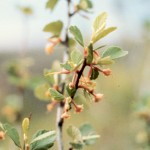Mountain Mahogany , Alderleaf Mountain Mahogany
Cercocarpus montanus
Rosaceae
Description
Three varieties of Mountain Mahogany grow as shrubs or small trees (reaching 15-20 ft or 4.5 to 6 m) in Texas: C. montanus, C. montanus var argenteus, and C. montanus var paucidentatus. The latter two are known as Silver Mountain Mahogany and Hairy Mountain Mahogany, respectively. As members of the rose family, they are identified most easily in the field by distinctive fruit which have a 3 to 10 cm featherlike tail, leaves with many veins radiating from their center, and leaf margins toothed on the upper one-third to half. They often have a crooked trunk and stout, red, and rigid twigs. The wood is dark-colored. The leaves are simple and often more than an inch or 2.5 cm long with heavily toothed margins toward the apex. The leaves often present as fascicled on short spurs. In general, they are about twice as long as wide. Other leaf characteristics include a green upper side with a paler and densely hairy underside, short (< 1 cm) petioles, and leaf stipules fused to the petiole base. From March to July, Mountain Mahogany produces small green to cream-colored flowers lacking corollas and often in clusters of two or three on the short spur-like branches. The fruit is a silky-hairy cylinder measuring one centimeter with a whitish plume-like tail reaching 10 cm. The tail allows the seeds to be carried long distances by the wind. The plant is an excellent browse plant for deer and elk as well as cattle and goats, but as Kingsbury states in Poisonous Plants of the United States and Canada “only when not containing dangerous amounts of a cyanogenetic glycoside.”Habitat
Mountain Mahogany grows primarily on ledges and rims of rough terrain in the uplands of the Trans-Pecos, western Edwards Plateau, and the Panhandle. It grows roughly from 300 to 2100 m in elevation in dry gravelly soils.Toxic Agent
Mountain Mahogany contains concentrations of cyanogenic glycosides that under certain conditions are broken down to release cyanide. The toxins in the plant are usually, but not always, below the dangerous level. Influences such as bruising, wilting, withering, or drying of leaves appear to contribute to cyanide production. Wilted leaves from cutting the plant appear to be the most dangerous. All domestic animals are subject to cyanide poisoning, although ruminants are the most susceptible.Signs of Livestock Ingestion
Cyanide is one of the most rapidly acting poisons. Signs of illness may start within 5 minutes from the time the animal begins eating the plant. Death may occur within 15 minutes or several hours. Clinical signs generally occur in this order: Salivation and labored breathing; Muscle tremors; Incoordination; Bright red venous blood; Convulsions; Death from respiratory failure.Management Strategies
Even plants containing a high level of cyanogenic glycoside may not poison livestock. Because poisoning depends on the presence of free cyanide, anything preventing its development in the gastrointestinal tract can lessen or eliminate the danger of poisoning. Certain feeds, such as alfalfa hay and linseed cake, retard the production of cyanide and may prevent poisoning. If signs are typical of cyanide poisoning, treat with sodium nitrite followed by sodium thiosulfate. Remove animals from infested pastures at the first signs of poisoning.Images
Plant Characteristics
Flower Color: Cream, Green, White
Seed Type: Non-Encapsulated
Duration: Perennial
Stem Texture: Hairless/Smooth
Growth Habit: Shrub (Woody), Tree
Leaf Shape
 : Simple with Pinnate or Parallel Venation
: Simple with Pinnate or Parallel Venation
Season: Warm
Distribution
 : 07 - Edwards Plateau, 08 - Rolling Plains, 09 - High Plains, 10 - Trans-Pecos
: 07 - Edwards Plateau, 08 - Rolling Plains, 09 - High Plains, 10 - Trans-Pecos
Distributions
Distribution refers to the ecological region in Texas that a plant has been found. You can also view a clickable map.
Book: Toxic Plants of Texas (B-6105)
Collection: Toxics
Livestock Affected: Cattle, Goats, Horses, Sheep
Livestock Signs: Bright Red Blood, Convulsions, Excess Salivation, Incoordination, Trembling





